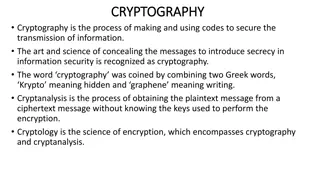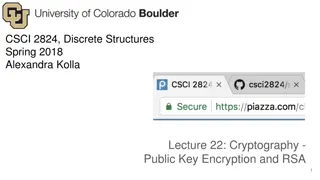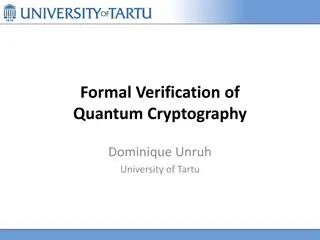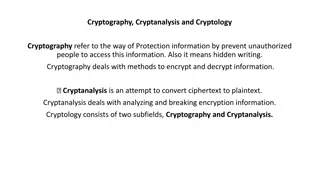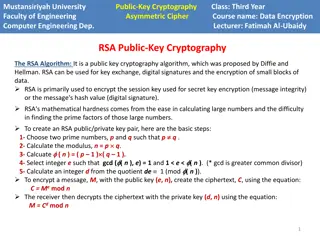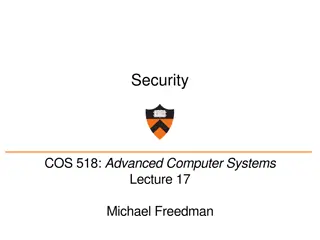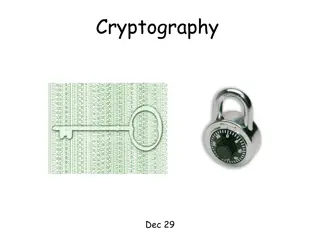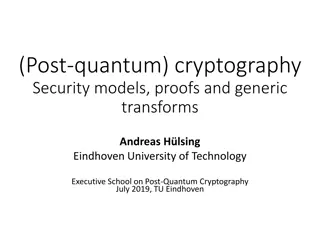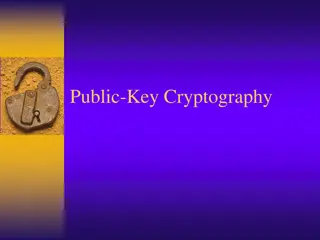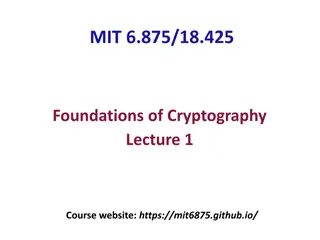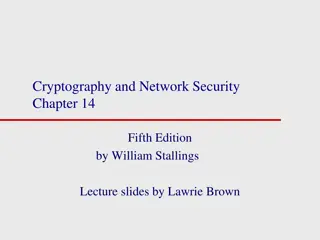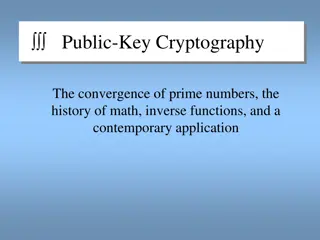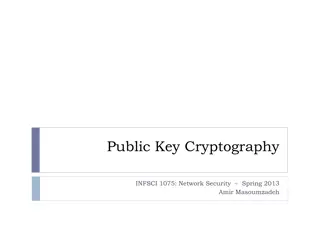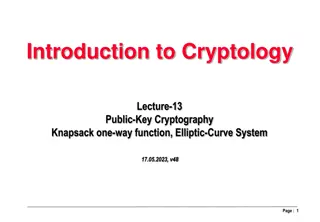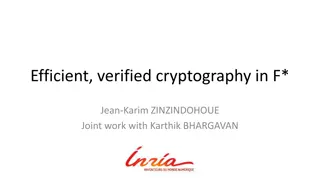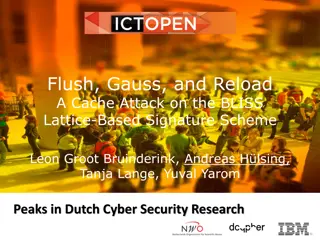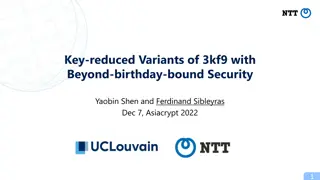Introduction to Public Key Cryptography
Public key cryptography, exemplified by algorithms like Diffie-Hellman and RSA, revolutionizes secure communication by allowing users to encrypt messages with public keys known to all and decrypt them with private keys known only to the intended recipient. This advanced encryption method ensures secure key exchange over networks without the need for prior key agreements. The process involves using public and private keys to encrypt and decrypt messages, with RSA being a prominent encryption algorithm ensuring the impossibility of deriving the private key from the public key. Modular arithmetic forms the basis of cryptographic operations, enabling unique representations of messages as integer numbers for encryption. The RSA algorithm involves creating a public-private key pair by selecting prime numbers, computing values, and ensuring key pairs with specific mathematical relationships.
Download Presentation

Please find below an Image/Link to download the presentation.
The content on the website is provided AS IS for your information and personal use only. It may not be sold, licensed, or shared on other websites without obtaining consent from the author.If you encounter any issues during the download, it is possible that the publisher has removed the file from their server.
You are allowed to download the files provided on this website for personal or commercial use, subject to the condition that they are used lawfully. All files are the property of their respective owners.
The content on the website is provided AS IS for your information and personal use only. It may not be sold, licensed, or shared on other websites without obtaining consent from the author.
E N D
Presentation Transcript
Public Key Cryptography public key crypto radically different approach [Diffie- Hellman76, RSA78] sender, receiver do not share secret key public encryption key known to all private decryption key known only to receiver symmetric key crypto requires sender, receiver know shared secret key Q: how to agree on key in first place (particularly if never met )? Network Security 8-2
Public key cryptography + Bob s public key K B - Bob s private key K B encryption algorithm decryption algorithm plaintext message m = K (K (m)) B plaintext message, m ciphertext K (m) B + - + B Network Security 8-3
Public key encryption algorithms requirements: . - . + - need K ( ) and K ( ) such that B K (K (m)) = m B B 1 B + + 2 given public key K , it should be impossible to compute private key K B B - RSA: Rivest, Shamir, Adelson algorithm Network Security 8-4
Prerequisite: modular arithmetic x mod n = remainder of x when divide by n facts: [(a mod n) + (b mod n)] mod n = (a+b) mod n [(a mod n) - (b mod n)] mod n = (a-b) mod n [(a mod n) * (b mod n)] mod n = (a*b) mod n thus (a mod n)d mod n = ad mod n example: x=14, n=10, d=2: (x mod n)d mod n = 42 mod 10 = 6 xd = 142 = 196 xd mod 10 = 6 Network Security 8-5
RSA: getting ready message: just a bit pattern bit pattern can be uniquely represented by an integer number thus, encrypting a message is equivalent to encrypting a number. example: m= 10010001 . This message is uniquely represented by the decimal number 145. to encrypt m, we encrypt the corresponding number, which gives a new number (the ciphertext). Network Security 8-6
RSA: Creating public/private key pair 1. choose two large prime numbers p, q. (e.g., 1024 bits each) 2. compute n = pq, z = (p-1)(q-1) 3. choose e (with e<n) that has no common factors with z (e, z are relatively prime ). 4. choose d such that ed-1 is exactly divisible by z. (in other words: ed mod z = 1 ). 5. public key is (n,e).private key is (n,d). + - KB K B Network Security 8-7
RSA: encryption, decryption 0. given (n,e) and (n,d) as computed above 1. to encrypt message m (<n), compute c = m mod n e 2. to decrypt received bit pattern, c, compute m = c mod n d magic d e m = (m mod n) mod n happens! c Network Security 8-8
RSA example: Bob chooses p=5, q=7. Then n=35, z=24. e=5 (so e, z relatively prime). d=29 (so ed-1 exactly divisible by z). encrypting 8-bit messages. me e m bit pattern c = m mod n encrypt: 17 24832 12 0000l000 cd d c m = c mod n decrypt: 17 12 481968572106750915091411825223071697 Network Security 8-9
Why does RSA work? must show that cd mod n = m where c = me mod n fact: for any x and y: xy mod n = x(y mod z) mod n where n= pq and z = (p-1)(q-1) thus, cd mod n = (me mod n)d mod n = med mod n = m(ed mod z) mod n = m1 mod n = m Network Security 8-10
RSA: another important property The following property will be very useful later: - + - + K (K (m)) = m B B K (K (m)) B B = use private key first, followed by public key use public key first, followed by private key result is the same! Network Security 8-11
- + - Why + ? K (K (m)) = m B B K (K (m)) B B = follows directly from modular arithmetic: (me mod n)d mod n = med mod n = mde mod n = (md mod n)e mod n Network Security 8-12
Why is RSA secure? suppose you know Bob s public key (n,e). How hard is it to determine d? essentially need to find factors of n without knowing the two factors p and q fact: factoring a big number is hard Network Security 8-13
RSA in practice: session keys exponentiation in RSA is computationally intensive DES is at least 100 times faster than RSA use public key cryto to establish secure connection, then establish second key symmetric session key for encrypting data session key, KS Bob and Alice use RSA to exchange a symmetric key KS once both have KS, they use symmetric key cryptography Network Security 8-14
Chapter 8 roadmap 8.1 What is network security? 8.2 Principles of cryptography 8.3 Message integrity, authentication 8.4 Securing e-mail 8.5 Securing TCP connections: SSL 8.6 Network layer security: IPsec 8.7 Securing wireless LANs 8.8 Operational security: firewalls and IDS Network Security 8-15
Authentication Goal: Bob wants Alice to prove her identity to him Protocol ap1.0: Alice says I am Alice I am Alice Failure scenario?? Network Security 8-16
Authentication Goal: Bob wants Alice to prove her identity to him Protocol ap1.0: Alice says I am Alice in a network, Bob can not see Alice, so Trudy simply declares herself to be Alice I am Alice Network Security 8-17
Authentication: another try Protocol ap2.0: Alice says I am Alice in an IP packet containing her source IP address Alice s IP address I am Alice Failure scenario?? Network Security 8-18
Authentication: another try Protocol ap2.0: Alice says I am Alice in an IP packet containing her source IP address Trudy can create a packet spoofing Alice s address Alice s IP address I am Alice Network Security 8-19
Authentication: another try Protocol ap3.0: Alice says I am Alice and sends her secret password to prove it. Alice s password Alice s IP addr I m Alice Failure scenario?? Alice s IP addr OK Network Security 8-20
Authentication: another try Protocol ap3.0: Alice says I am Alice and sends her secret password to prove it. Alice s password Alice s IP addr I m Alice playback attack: Trudy records Alice s packet and later plays it back to Bob Alice s IP addr OK Alice s password Alice s IP addr I m Alice Network Security 8-21
Authentication: yet another try Protocol ap3.1: Alice says I am Alice and sends her encrypted secret password to prove it. encrypted password Alice s IP addr I m Alice Failure scenario?? Alice s IP addr OK Network Security 8-22
Authentication: yet another try Protocol ap3.1: Alice says I am Alice and sends her encrypted secret password to prove it. encrypted password Alice s IP addr I m Alice record and playback still works! Alice s IP addr OK encrypted password Alice s IP addr I m Alice Network Security 8-23
Authentication: yet another try Goal: avoid playback attack nonce: number (R) used only once-in-a-lifetime ap4.0: to prove Alice live , Bob sends Alice nonce, R. Alice must return R, encrypted with shared secret key I am Alice R Alice is live, and only Alice knows key to encrypt nonce, so it must be Alice! K (R) A-B Failures, drawbacks? Network Security 8-24
Authentication: ap5.0 ap4.0 requires shared symmetric key can we authenticate using public key techniques? ap5.0: use nonce, public key cryptography I am Alice Bob computes (K (R)) = R A K A and knows only Alice could have the private key, that encrypted R such that (K (R)) = R A - R + - K (R) A send me your public key + K A - + K A Network Security 8-25
ap5.0: security hole man (or woman) in the middle attack: Trudy poses as Alice (to Bob) and as Bob (to Alice) I am Alice I am Alice R - K (R) T R Send me your public key - K + K (R) A T Send me your public key K + A + K (m) T Trudy gets - + T m = K (K (m)) sends m to Alice encrypted with Alice s public key + T K (m) A - + A m = K (K (m)) A Network Security 8-26
ap5.0: security hole man (or woman) in the middle attack: Trudy poses as Alice (to Bob) and as Bob (to Alice) difficult to detect: Bob receives everything that Alice sends, and vice versa. (e.g., so Bob, Alice can meet one week later and recall conversation!) problem is that Trudy receives all messages as well! Network Security 8-27
Chapter 8 roadmap 8.1 What is network security? 8.2 Principles of cryptography 8.3 Message integrity, authentication 8.4 Securing e-mail 8.5 Securing TCP connections: SSL 8.6 Network layer security: IPsec 8.7 Securing wireless LANs 8.8 Operational security: firewalls and IDS Network Security 8-28
Digital signatures cryptographic technique analogous to hand-written signatures: sender (Bob) digitally signs document, establishing he is document owner/creator. verifiable, nonforgeable: recipient (Alice) can prove to someone that Bob, and no one else (including Alice), must have signed document Network Security 8-29
Digital signatures simple digital signature for message m: Bob signs m by encrypting with his private key KB, creating signed message, KB(m) - - - -(m) Bob s private key Bob s message, m K B m,K B Dear Alice Bob s message, m, signed (encrypted) with his private key Public key encryption algorithm Oh, how I have missed you. I think of you all the time! (blah blah blah) Bob Network Security 8-30
Digital signatures - suppose Alice receives msg m, with signature: m, KB(m) Alice verifies m signed by Bob by applying Bob s public key KB to KB(m) then checks KB(KB(m) ) = m. If KB(KB(m) ) = m, whoever signed m must have used Bob s private key. - - + + - + Alice thus verifies that: Bob signed m no one else signed m Bob signed m and not m non-repudiation: Alice can take m, and signature KB(m) to court and prove that Bob signed m - Network Security 8-31
Message digests large message m H: Hash Function computationally expensive to public-key-encrypt long messages goal: fixed-length, easy- to- compute digital fingerprint apply hash function H to m, get fixed size message digest, H(m). H(m) Hash function properties: many-to-1 produces fixed-size msg digest (fingerprint) given message digest x, computationally infeasible to find m such that x = H(m) Network Security 8-32
Internet checksum: poor crypto hash function Internet checksum has some properties of hash function: produces fixed length digest (16-bit sum) of message is many-to-one But given message with given hash value, it is easy to find another message with same hash value: ASCII format message ASCII format message I O U 9 0 0 . 1 9 B O B 49 4F 55 39 30 30 2E 31 39 42 D2 42 I O U 1 0 0 . 9 9 B O B 49 4F 55 31 30 30 2E 39 39 42 D2 42 B2 C1 D2 AC B2 C1 D2 AC different messages but identical checksums! Network Security 8-33
Digital signature = signed message digest Bob sends digitally signed message: Alice verifies signature, integrity of digitally signed message: large message m H: Hash function encrypted msg digest H(m) - KB(H(m)) digital signature (encrypt) large message m Bob s private key K B Bob s public key K B - digital signature (decrypt) + H: Hash function encrypted msg digest - + KB(H(m)) H(m) H(m) equal ? Network Security 8-34
Hash function algorithms MD5 hash function widely used (RFC 1321) computes 128-bit message digest in 4-step process. arbitrary 128-bit string x, appears difficult to construct msg m whose MD5 hash is equal to x SHA-1 is also used US standard [NIST, FIPS PUB 180-1] 160-bit message digest Network Security 8-35
Recall: ap5.0 security hole man (or woman) in the middle attack: Trudy poses as Alice (to Bob) and as Bob (to Alice) I am Alice I am Alice R - K (R) T R Send me your public key - K + K (R) A T Send me your public key K + A + K (m) T Trudy gets - + T m = K (K (m)) sends m to Alice encrypted with Alice s public key + T K (m) A - + A m = K (K (m)) A Network Security 8-36
Public-key certification motivation: Trudy plays pizza prank on Bob Trudy creates e-mail order: Dear Pizza Store, Please deliver to me four pepperoni pizzas. Thank you, Bob Trudy signs order with her private key Trudy sends order to Pizza Store Trudy sends to Pizza Store her public key, but says it s Bob s public key Pizza Store verifies signature; then delivers four pepperoni pizzas to Bob Bob doesn t even like pepperoni Network Security 8-37
Certification authorities certification authority (CA): binds public key to particular entity, E. E (person, router) registers its public key with CA. E provides proof of identity to CA. CA creates certificate binding E to its public key. certificate containing E s public key digitally signed by CA CA says this is E s public key digital signature (encrypt) Bob s public key K B + K B + CA key K CA certificate for Bob s public key, signed by CA - private Bob s identifying information Network Security 8-38
Certification authorities when Alice wants Bob s public key: gets Bob s certificate (Bob or elsewhere). apply CA s public key to Bob s certificate, get Bob s public key digital signature (decrypt) Bob s public key + K B + K B CA + public key K CA Network Security 8-39
Chapter 8 roadmap 8.1 What is network security? 8.2 Principles of cryptography 8.3 Message integrity, authentication 8.4 Securing e-mail 8.5 Securing TCP connections: SSL 8.6 Network layer security: IPsec 8.7 Securing wireless LANs 8.8 Operational security: firewalls and IDS Network Security 8-40
Secure e-mail Alice wants to send confidential e-mail, m, to Bob. KS KS( ). KS( ). KS(m ) KS(m ) m m - + KS KB( ). Internet KB( ). - + KS + + KB(KS ) KB(KS ) KB- KB+ Alice: generates random symmetric private key, KS encrypts message with KS (for efficiency) also encrypts KS with Bob s public key sends both KS(m) and KB(KS) to Bob Network Security 8-41
Secure e-mail Alice wants to send confidential e-mail, m, to Bob. KS KS( ). KS( ). KS(m ) KS(m ) m m - + KS KB( ). Internet KB( ). - + KS + + KB(KS ) KB(KS ) KB- KB+ Bob: uses his private key to decrypt and recover KS uses KS to decrypt KS(m) to recover m Network Security 8-42
Secure e-mail (continued) Alice wants to provide sender authentication message integrity KA+ KA- KA( ). - - KA( ). H( ). KA(H(m)) + KA(H(m)) - H(m ) m - + compare Internet H( ). m H(m ) m Alice digitally signs message sends both message (in the clear) and digital signature Network Security 8-43
Secure e-mail (continued) Alice wants to provide secrecy, sender authentication, message integrity. KA - - KA( ). H( ). KA(H(m)) - KS m KS( ). + + m Internet KB( ). + KS + KB(KS ) KB+ Alice uses three keys: her private key, Bob s public key, newly created symmetric key Network Security 8-44




